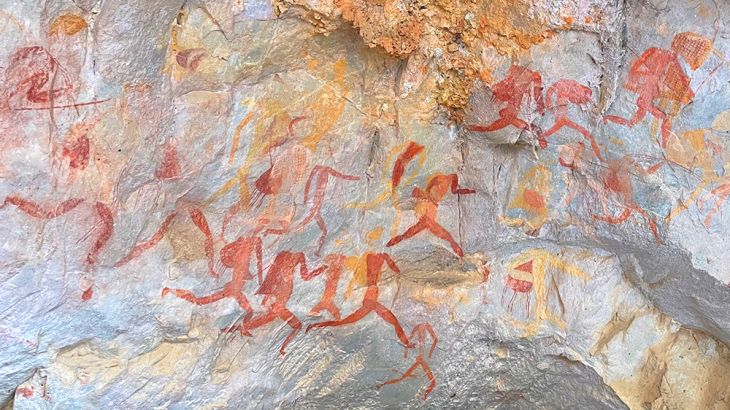In a new exhibition, archaeologist Vibeke M. Viestad shows how we can use San people's dress and dress practices to interpret their world-renowned rock art in new ways.
FAMOUS ROCK ART: Vibeke Viestad believes it is likely that the San people's rock paintings were created and used in other contexts than previously assumed. This image shows a rock painting created by San people in the Groot Winterhoek Mountains in South Africa. Photo: Vibeke Viestad.
For thousands of years, the San people painted fantastic and complex rock paintings that can be found scattered across southern Africa.
But despite their early and advanced visual communication the historical hunter-gatherer population has often been described as "primitive Stone Age people".
“The San people were neither primitive nor naked. They used clothes, headdresses, bags, shoes, jewelry, tattoos, colors, and fragrance to create and maintain important social relationships between humans, between humans and animals, and between humans and other living beings. Dressing the body helped create harmonious relationships that were important for living in a world that consisted of many different types of social beings," Viestad says.
Has opened an exhibition in South Africa
 STUDIES DRESS PRACTICES: Vibeke Viestad at Department of Archaeology, Conservation and History, studies the connections between dress and art. Photo: private.
STUDIES DRESS PRACTICES: Vibeke Viestad at Department of Archaeology, Conservation and History, studies the connections between dress and art. Photo: private.
Viestad’s exhibition The Origin of the World. Creation and transformation in San dress, narrative and rock art, is currently on display at the Origins Centre at Witwatersrand University in Johannesburg.
The exhibition, which is based on her research, shows what dress practices has meant to San people.
Through ethnographic artifacts, photographs, reproductions of rock art and information texts, she explains how dress and personal ornamentation have been used intentionally, and that they have had different significance in different phases of San people’s lives.
It is here that the connection to rock art becomes evident: The knowledge of dress and dress practices can contribute to understanding parts of the rock art and its symbolism in new ways, according to Viestad.
“The traditional interpretation of rock art is that it shows trance dance as a ritual practice, specifically the shaman's role and ability to move between different worlds during a trance.”
“By emphasizing what clothes, bags and decoration of the body have meant in different situations, we can understand the symbolism and significance of rock art in other ways. It is likely that the art was created and used in many different contexts, not just to convey the shaman's perspective and experiences,” Viestad says.
 FROM THE EXHIBITION: The focus of Viestad's exhibition is what dress and dress practices has meant in different phases of San people's lives. This image shows a leather apron from Namibia, decorated with ostrich eggshell beads. Photo: Goeun Botha.
FROM THE EXHIBITION: The focus of Viestad's exhibition is what dress and dress practices has meant in different phases of San people's lives. This image shows a leather apron from Namibia, decorated with ostrich eggshell beads. Photo: Goeun Botha.
Shows the man as a hunter, the woman as a gatherer
Viestad believes that many of the rock art images can be linked to rites of passage – and to the man's identity as a hunter and the woman's identity as a gatherer.
"We know that dressing in new or borrowed clothes and getting tattooed or painted has been an important part of rituals of transition from young to adult woman, from young boy to adult hunter or from novice to healer,” she says.
In the exhibition she shows examples of this. There are pictures of a group of people sitting close together covered in large skin cloaks, inside an enclosure that is secluded from the rest of the world.
Hunting bags have been painted over their heads, and in some of the pictures the distinction between animal and human is almost non-existing because the group can also be seen as the body of a large antelope.
Viestad explains that this represents the rite of passage for young hunters, and that the interpretation coincides with what has been described in written sources from the early twentieth century.
"In some overhangs, several of these groups are painted, probably at different points in time. Perhaps they came back to perform the ritual, or to commemorate it."
 RITE OF PASSAGE: For the San people, dress and decoration played an important role in the transition to adulthood. This image shows headbands made of ostrich eggshell beads. Photo: Goeun Botha.
RITE OF PASSAGE: For the San people, dress and decoration played an important role in the transition to adulthood. This image shows headbands made of ostrich eggshell beads. Photo: Goeun Botha.
San people tattooed themselves before hunting to identify with the animal
Viestad's exhibition consists of six sections that follow the dressed body: leather clothes, bags, shoes, tattoos, beadwork and tortoise shell boxes filled with fragrant herbs and plants.
Each section presents brief summaries of myths and stories where clothing and personal adornment play a crucial role. Viestad points out that myths can help explain actions, or associations that were important in the real world, and exemplifies:
In the story of when animals became animals and humans became humans, all animals had marks and stripes branded into their fur.
The different characteristics set them apart as separate species, and people thought the patterns were so beautiful that they wanted to imitate the marks on their own bodies.
“In the real world, girls' tattoos were often directly compared to the beauty of the zebra. And for the hunter, it was important to "know" or “feel” the animal, identify with it, so that the animal he was hunting would not be frightened and disappear. He was able to achieve this by rubbing charred meat from previous hunts into parallel cuts on his arms, face or back," Viestad explains.
It was important to create harmonious relationships
Another myth tells the story about a young girl who rubs the powder of fragrant plants over the neck of the “Water” to calm the creature and escape herself.
Viestad believes that we can draw parallels from this story to young girls in the real world, because San-girls have used similar powder, collected in beautiful boxes made from tortoise shell.
“By powdering themselves and their loved ones, they became protected from the "angry water" that falls with lightning and thunder. The hope was that it would rather be the soft rain that would come to penetrate the dry ground, making it fertile,” Viestad explains.
She further states that there are several examples in rock art that can be interpreted as decorated boxes made from tortoise shell.
“It seems that we can connect these boxes to the beliefs surrounding water and young girls' special relationship with water.”
 IMPORTANT PLANT: The San people rubbed themselves with powder from the buchu plant for protection from the "angry water". Buchu was also used as a medicinal plant. Photo: Goeun Botha.
IMPORTANT PLANT: The San people rubbed themselves with powder from the buchu plant for protection from the "angry water". Buchu was also used as a medicinal plant. Photo: Goeun Botha.
The importance of studying dress and dress practices
According to Viestad, studying the practice of dress and bodily expression is one of several keys to understanding cultural, ritual, and economic behavior among people.
"In other fields of anthropological and archaeological research, clothing has often been taken seriously. When it comes to previous research on the San people, however, this has not been done to the same extent,” she says.
She believes that this is due to Western prejudices that San people were naked, or almost naked. Viestad believes that her research has contributed to a new perspective on this – and on the complex culture of the historical San people.
"The research has contributed to an increased knowledge about their lives and world views. In this way, I have also helped to expose some of the underlying prejudices that still prevail about San people and their culture,” she says.
The first exhibition of its kind
As far as Viestad knows, the exhibition is the first of its kind to present the importance of dress as cultural practice among the San people.
"The exhibition adds to the knowledge about southern Africa's indigenous hunter-gatherer population, who live as highly marginalized and vulnerable minorities in their respective countries today," she says.
The Origins Centre is an important museum institution in terms of creating awareness with weekly visits from schools and students, a group Viestad believes is particularly important to reach with this type of knowledge.
“I want to contribute to increased understanding and tolerance between people. I think reaching young people is crucial to achieving this," she concludes.
About the research
The exhibition The Origin of the World. Creation and transformation in San dress, narrative and rock art, is based on the research of Vibeke M. Viestad at the Department of Archaeology, Conservation and History at the University of Oslo.
Viestad is an Honorary Research Fellow at the Rock Art Research Institute at the University of the Witwatersrand, where she was based for the past two years.
The exhibition showcases what dress and dress practices has meant to the historical San hunter-gatherers and takes place at the Origins Centre at the University of the Witwatersrand in Johannesburg, South Africa.
San is a collective term for the former hunter-gatherer populations of South Africa, Botswana, Namibia, Angola, Zambia and Zimbabwe.
Different San groups speak different languages and have different cultures.
Today, few San live traditional lives as hunter-gatherers, and most San communities are highly marginalized both politically and economically.
The amazing rock art in the Drakensberg and other mountain areas in South Africa, is associated with the San people who lived in the area.
Source:
Vibeke Viestad
















